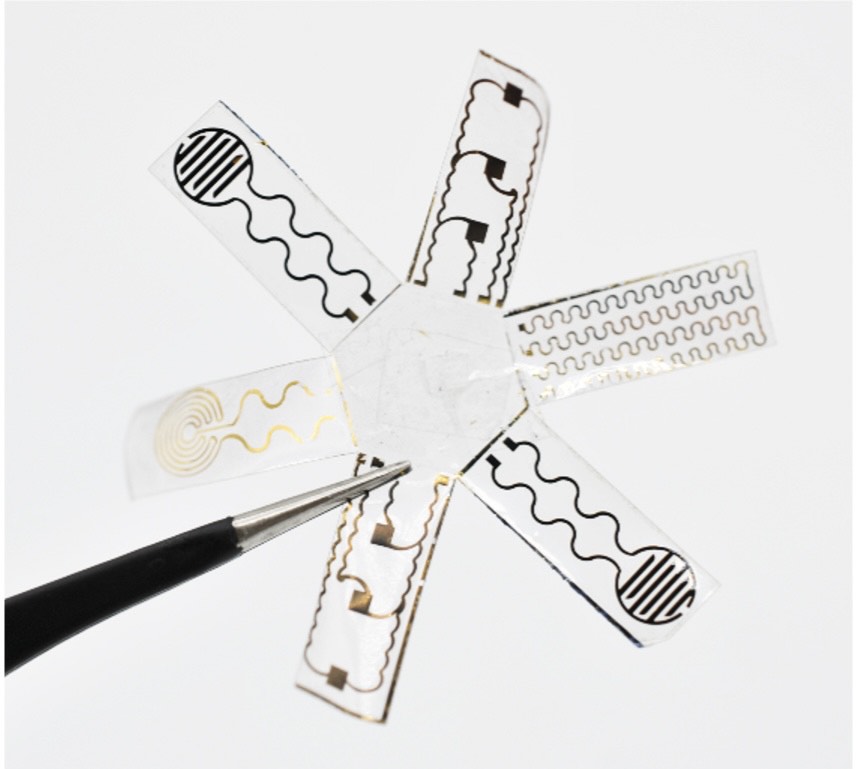Soft Robots with Electronic Skins and Artificial Muscles to Provide Medical Treatment
|
By HospiMedica International staff writers Posted on 12 Jun 2024 |

Researchers have developed advanced soft robots that are equipped with electronic skins and artificial muscles, enabling them to detect their environment and modify their actions in real time.
These robots were designed by a team at the University of North Carolina at Chapel Hill (Chapel Hill, NC, USA) to mimic the cooperative function of muscles and skin in animals, enhancing their efficiency and safety for internal use in the human body. The electronic skin of these robots incorporates a variety of sensing materials such as silver nanowires and conductive polymers embedded in a flexible substrate, mirroring the intricate sensory capabilities of natural skin. Capable of executing complex movements like bending, stretching, and twisting within biological settings, these soft robots are designed to attach smoothly to tissues, minimizing stress and potential harm. Drawing inspiration from natural forms such as starfish and seedpods, they can alter their structures to efficiently carry out diverse tasks. Such versatility makes these sensory soft robots highly adaptable and beneficial for advancing medical diagnostics and therapies. They can morph to conform to organs for improved sensing and treatment, perform ongoing monitoring of internal states such as bladder volume and blood pressure, deliver treatments like electrical stimulation based on live feedback, and be ingested to monitor and treat stomach-related issues.
A particular type of ingestible robot, known as a thera-gripper, is designed to stay in the stomach to monitor pH levels and administer medication over prolonged periods, thus enhancing treatment for gastrointestinal disorders. It can also attach to the heart, continuously tracking electrophysiological signals, measuring heart contractions, and providing electrical impulses to help maintain proper heart rhythm. Experiments conducted on mice have proven the thera-gripper’s effectiveness in fulfilling these roles, indicating its potential as an advanced cardiac implant. Additionally, a robotic gripper that can encircle a bladder can assess its volume and deliver electrical pulses to address overactivity, improving both patient care and treatment results. A robotic cuff that wraps around a blood vessel can measure blood pressure accurately and in real time, serving as a non-invasive and precise monitoring tool. The success of these robots in live animal tests points to a bright future for their application in medical settings, potentially transforming the management of chronic conditions and enhancing patient care.
“This innovative approach to robot design not only broadens the scope of medical devices but also highlights the potential for future advancements in the synergistic interaction between soft implantable robots and biological tissues,” said Wubin Bai, the principal investigator of the research and an APS assistant professor. “We’re aiming for long-term biocompatibility and stability in dynamic physiological environments.”
Related Links:
University of North Carolina at Chapel Hil
Latest Critical Care News
- Novel Cannula Delivery System Enables Targeted Delivery of Imaging Agents and Drugs
- Ingestible Smart Capsule for Chemical Sensing in the Gut Moves Closer to Market
- Novel Intrabronchial Method Delivers Cell Therapies in Critically Ill Patients on External Lung Support
- Generative AI Technology Detects Heart Disease Earlier Than Conventional Methods
- Wearable Technology Predicts Cardiovascular Risk by Continuously Monitoring Heart Rate Recovery
- Wearable Health Monitoring Device Measures Gases Emitted from and Absorbed by Skin
- Groundbreaking Technology Rapidly Detects Airborne Influenza Viruses
- Handheld Device Could Transform Heart Disease Screening
- Flexible Semi-Autonomous Robot Could Deliver Medicine Inside Body

- Neurorestorative Treatment Strategies Hold Promise for Most Severe Forms of Epilepsy
- Gene Discovery Could Help Grow New Heart Arteries
- Study Discovers Invisible Transmission of Common Hospital-Associated Infection
- Non-Invasive Neuro-Ophthalmology Techniques Could Detect Brain Tumors Earlier
- Mass Manufactured Nanoparticles to Deliver Cancer Drugs Directly to Tumors
- World’s Smallest Pacemaker Fits Inside Syringe Tip

- AI-Powered, Internet-Connected Medical Devices to Revolutionize Healthcare, Finds Study
Channels
Surgical Techniques
view channel
Intravascular Imaging for Guiding Stent Implantation Ensures Safer Stenting Procedures
Patients diagnosed with coronary artery disease, which is caused by plaque accumulation within the arteries leading to chest pain, shortness of breath, and potential heart attacks, frequently undergo percutaneous... Read more
World's First AI Surgical Guidance Platform Allows Surgeons to Measure Success in Real-Time
Surgeons have always faced challenges in measuring their progress toward surgical goals during procedures. Traditionally, obtaining measurements required stepping out of the sterile environment to perform... Read morePatient Care
view channel
Portable Biosensor Platform to Reduce Hospital-Acquired Infections
Approximately 4 million patients in the European Union acquire healthcare-associated infections (HAIs) or nosocomial infections each year, with around 37,000 deaths directly resulting from these infections,... Read moreFirst-Of-Its-Kind Portable Germicidal Light Technology Disinfects High-Touch Clinical Surfaces in Seconds
Reducing healthcare-acquired infections (HAIs) remains a pressing issue within global healthcare systems. In the United States alone, 1.7 million patients contract HAIs annually, leading to approximately... Read more
Surgical Capacity Optimization Solution Helps Hospitals Boost OR Utilization
An innovative solution has the capability to transform surgical capacity utilization by targeting the root cause of surgical block time inefficiencies. Fujitsu Limited’s (Tokyo, Japan) Surgical Capacity... Read more
Game-Changing Innovation in Surgical Instrument Sterilization Significantly Improves OR Throughput
A groundbreaking innovation enables hospitals to significantly improve instrument processing time and throughput in operating rooms (ORs) and sterile processing departments. Turbett Surgical, Inc.... Read moreHealth IT
view channel
Printable Molecule-Selective Nanoparticles Enable Mass Production of Wearable Biosensors
The future of medicine is likely to focus on the personalization of healthcare—understanding exactly what an individual requires and delivering the appropriate combination of nutrients, metabolites, and... Read more
Smartwatches Could Detect Congestive Heart Failure
Diagnosing congestive heart failure (CHF) typically requires expensive and time-consuming imaging techniques like echocardiography, also known as cardiac ultrasound. Previously, detecting CHF by analyzing... Read moreBusiness
view channel
Expanded Collaboration to Transform OR Technology Through AI and Automation
The expansion of an existing collaboration between three leading companies aims to develop artificial intelligence (AI)-driven solutions for smart operating rooms with sophisticated monitoring and automation.... Read more

















